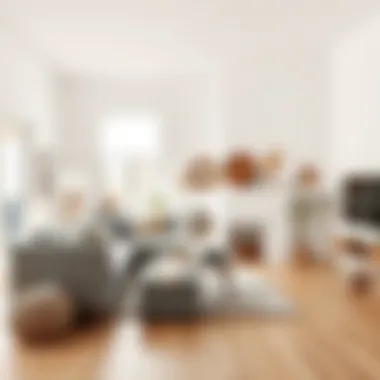Elevate Your Living Room Decor: Trends and Tips


Intro
The living room is often considered the heart of a home. It’s where we gather with our family, entertain friends, or simply unwind after a long day. The decor we choose can transform a bland space into a warm, inviting area that reflects our personal style. This article seeks to guide you through the intricacies of living room decor by examining key design principles, trending aesthetics, and the fruits of thoughtful decoration.
As we dive into the multitude of styles and elements that can breathe life into your living room, we’ll also tackle the practical aspects of implementing these ideas. From furniture selection to color palettes and the essential details that make a house a home, our focus remains on creating an atmosphere that is both appealing and functional. Challenges come and go in every decor journey, and our aim is to provide insights and solutions to inspire your own decor endeavors.
So, whether you’re a seasoned designer or a homeowner looking to refresh your space, prepare to embark on a visual journey that enriches your understanding of living room decor.
Understanding Living Room Decor
When it comes to interior design, the living room holds a special place in the hearts of homeowners and decorators alike. This space serves as both a sanctuary for relaxation and a gathering point for family and friends. Understanding living room decor is not merely about arranging furniture or choosing colors; it's about crafting an environment that reflects one's lifestyle and values while ensuring comfort and functionality.
The living room often acts as a barometer of personal style. It’s where design choices can convey messages about one's aesthetic preferences, cultural influences, and even social aspirations. The importance of this understanding lies in the ability to harmonize numerous elements that contribute to the overall ambiance. From color palettes that evoke certain moods to furniture that not only looks great but serves a purpose, there’s much to consider.
The Role of the Living Room
In various cultures, the living room plays a pivotal role, akin to a stage where stories unfold. It's a setting where daily life happens, hosting everything from quiet evening retreats to lively gatherings. The multifaceted role encompasses entertainment, relaxation, and social interaction. This is why investing thought and care into decor choices carries weight—it impacts how those who enter feel in your space.
Apart from its social functions, the living room also serves as a reflection of personal and family identity. For some, it might be adorned with photographs that capture cherished memories; for others, it could be a canvas for displaying collected art reflecting travel adventures. The decor speaks volumes, setting the mood and creating an inviting atmosphere.
Components of Living Room Decor
Diving into the specifics, living room decor comprises various components that work symbiotically to create a cohesive look. Each element, whether furniture, color, or accessories, plays a crucial role:
- Furniture: The backbone. Sofas, chairs, and coffee tables shape the layout and functionality. Choosing the right scale and style is essential—too big and you choke the space, too small and you lose functionality.
- Color Scheme: This is where the mood begins. Colors affect energy and perception. Warmer tones can create coziness, while cool tones might lend a more serene vibe.
- Accessories: Everything from cushions and rugs to books and plants spruces up the space. These add personal touches that can transform a room from ordinary to extraordinary.
"A living room can be functional yet stylish, and every piece should tell a story—yours."
- Lighting: Often overlooked, lighting can change the game. Natural light during the day enriches space, while layered lighting—ambient, task, and accent—ensures your living room stays adaptable for various scenarios, whether chilling alone with a book or entertaining guests.
- Textures: Introducing different materials—from soft fabrics to hard surfaces—adds depth. A combination of textiles can create visual interest and tactile variety, inviting touch and encouraging interaction.
Understanding these components doesn't just elevate the aesthetic appeal; it fosters an environment where function meets form, and your living room can become a true extension of you.
Key Design Principles
Design principles serve as the backbone of any successful interior decor project, especially when it comes to the living room. This area of the home is often where families gather, entertain guests, and unwind. Thus, understanding these principles can elevate the overall functionality and aesthetics of the space. Good design does not merely happen by chance; it requires thoughtful consideration and a strategic approach.
One critical facet of design principles is the ability to create a cohesive look. Cohesion encourages various elements—from furniture to color palettes—to work harmoniously together. Without this unity, a living room can feel disjointed, even chaotic. Homeowners must consider how colors, textures, and shapes speak to each other in a space meant for comfort and interaction.
Furthermore, these principles promote functionality. Designing a living room with both beauty and practicality in mind can significantly enhance daily life. The goal is to create spaces that facilitate ease of movement while still being visually appealing. Integrating everyday needs with stylish design becomes paramount.
Color Theory in Living Spaces
Color is one of the most powerful tools in design, influencing mood and perception. In a living room, the selection of hues can drastically transform its ambiance. Warm colors such as reds and yellows can create an inviting atmosphere, encouraging social interaction. They make a room feel more vibrant and alive.
On the other hand, cooler shades like blues and greens promote calmness and tranquility, making them excellent choices for spaces intended for relaxation. Understanding how light impacts color choice is equally crucial. Natural light can be a game-changer, altering the way colors appear throughout the day. Designers often recommend testing paint swatches at different times to see how light interacts with the colors.
Additionally, the use of color accents can effectively draw the eye to specific areas of the room. Throw pillows, artwork, or a striking armchair can introduce a splash of color without overwhelming the senses.
"Color is a power which directly influences the soul." – Wassily Kandinsky
This leads to the idea that a well-thought-out color scheme not only beautifies the room but can also elevate emotions and energy within the space.
Balancing Elements and Space
Balancing elements in your living room requires a nuanced approach. Achieving this balance involves juxtaposing various furnishings and decor items to create visual interest while ensuring a sense of harmony. One part of this process is understanding scale and proportion. Large pieces of furniture in a small room can make the space feel cramped, while tiny accents in a vast room can disappear entirely.
Another key aspect of balance is symmetry versus asymmetry. Symmetrical arrangements often evoke a sense of formality and order, which may work well in traditional settings. Conversely, asymmetrical designs bring a modern flair, inviting creativity and comfort. Finding the right mix that aligns with one’s personal style is what makes living room design an enjoyable endeavor.
Creating zones within the living room can also enhance balance. For instance, a seating area for conversations, a nook for reading, and a corner for entertainment can help facilitate different activities while ensuring the overall space feels cohesive.
Ultimately, it's about finding a sweet spot where each element—be it a chair, rug, or piece of art—has room to breathe while contributing to the overall purpose of the living room.
Popular Living Room Styles
When it comes to making a living room feel like home, the design style one chooses plays a vital role. It’s not merely about aesthetics; it's about crafting an atmosphere that resonates with personal taste and lifestyle needs. Each style serves as a lens through which to view the art of living space's design, allowing homeowners and decorators to showcase creativity, functionality, and comfort. This section explores a variety of popular styles that stand out, each bringing its own unique flavor to the living space.
Modern Minimalism
At the heart of modern minimalism lies the principle of 'less is more.' This style champions simplicity and clean lines, creating a serene environment that can often feel like a breath of fresh air in today's chaotic world. Minimalist living rooms often feature cohesive color palettes, predominantly neutrals, accented with sleek furniture and open spaces that foster flow and freedom of movement.
Important elements of modern minimalism include:
- Functional Furniture: Items often serve multiple purposes, such as a sofa bed for guests or a coffee table with hidden storage.
- Natural Light: Large windows or open layouts are staples, allowing an abundance of light to flood the space, enhancing the airy feel.
- Decluttered Surfaces: The fewer objects visible, the better. Each piece should have a purpose, contributing to a sound and calming aesthetic.
Consider this: while minimalism can be stark, it can also evoke warmth through textures and materials. Think of soft wool throws or a leather armchair that adds character without overwhelming the senses.
Classic Elegance
Classic elegance is about timelessness, sophistication, and a nod to historical influences in design. This style doesn’t shy away from opulence; it embraces rich colors, intricate patterns, and luxurious fabrics. Think heavy draperies, plush sofas, and ornate light fixtures that elevate the space almost effortlessly.
Key features of classic elegance include:
- Color Schemes: Usually rich and bold, perhaps a deep navy blue or a regal emerald green, often balanced with softer whites and creams.
- Antique or Vintage Pieces: Incorporating items with history adds depth. This could be a beautiful heirloom chest or an antique side table.
- Symmetrical Layouts: Creating harmony in design, symmetrical arrangements can help ground the room, making it feel intentional and thoughtfully designed.
To enhance this classic approach, it is wise to use decorative elements like artwork or sculptures that resonate emotionally, telling a story layered in tradition and beauty.
Eclectic Fusion
Eclectic fusion is an embodiment of personality and individualism in decor. This style takes the notion of mixing different textiles, patterns, and colors and turns it into an art form. It’s often an exploration of contrasts: bold against subtle, vintage among the modern. The beauty of eclectic spaces lies in their unpredictability, creating an inviting atmosphere through diverse influences.
Important aspects of eclectic fusion include:


- Layering Textures: From soft cushions and woven throws to sleek glass tables, layers create intrigue and tactile richness.
- Mixing Eras and Styles: You might combine a retro chair with a contemporary sofa, seamlessly blending the past and present.
- Personal Touches: Including artwork from local artists or family photographs can form a narrative unique to the homeowners.
This style encourages experimentation. The more aspects are interwoven, the more telling the room becomes, expressing not just taste but also the personal journey of those living within it.
"Your living room reflects your identity; let every corner be a chapter of your story."
Selecting Color Palettes
Color plays a pivotal role in interior design, acting as the heartbeat of any living space. Selecting the right color palette can significantly influence not just the aesthetic appeal but also the mood and functionality of the room. The act of choosing colors extends beyond personal preference; it intertwines with psychological principles and spatial dynamics. Thus, understanding the implications of your color choices forms the crux of transforming your living room into an inviting sanctuary.
When considering color palettes, it's essential to ponder the emotions and associations that different shades evoke. Warm colors like reds and oranges can invoke energy and warmth, making them suitable for social areas. Conversely, cooler shades, such as blues and greens, often promote calm and relaxation, ideal for unwinding. This understanding allows homeowners to curate spaces in alignment with their daily activities and emotional needs.
Moreover, the color palette helps in establishing a cohesive style throughout the living room and beyond, ensuring that every corner contributes to the overall theme. The balance of colors creates a flow, guiding the eyes naturally throughout the space.
Neutral Tones
Neutral colors serve as a versatile backdrop for any living room design. Shades like whites, creams, greys, and browns are often considered a blank slate, allowing other design elements to shine. One of the advantages of neutral tones is their ability to make a room feel larger and more open. This characteristic is particularly crucial in smaller living rooms where space is at a premium.
Incorporating neutrals provides a calming effect, making them suitable for spaces meant for relaxation and gathering. They effectively reflect light, enhancing brightness and airiness. A living room drenched in earthy hues, for example, can evoke a sense of warmth and comfort, drawing family members and friends alike.
Another remarkable feature of neutral palette choices is their adaptability. Homeowners can easily switch decorative elements, such as cushions or artwork, to introduce seasonal changes or fresh trends without needing to repaint the walls.
"In the world of decor, neutrality, sometimes, is your greatest ally, allowing for flexibility and timelessness."
Bold Accents
Adding bold accents within a neutral foundation can enliven the living room, injecting personality and vigor. Bright colors such as deep blues, vibrant yellows, or striking reds can serve as focal points or companions to more subdued tones.
The key here lies in moderation. Too many bold colors can overwhelm the eye, resulting in a chaotic atmosphere rather than the envisioned harmony. Instead, strategically placing these eye-catching elements ensures they draw attention effectively. For instance, a brightly colored sofa can become a statement piece against a backdrop of soft greys. Similarly, vivid artwork hung on a neutral wall can serve as a stunning conversation starter.
Apart from furnishings, bold accents can also manifest through decorative items such as pillows, rugs, and wall art. These smaller elements offer a relatively low-risk way to experiment with color without committing to permanent decisions.
In essence, merging neutral tones with bold accents creates a balanced setting that speaks volumes about the homeowner's persona while maintaining an inviting atmosphere.
Furniture Selection
Selecting furniture for your living room is paramount, as it sets the tone for the entire space. It’s not merely about filling up the area but about choosing pieces that harmonize with the overall design concept while catering to functionality. The furniture you pick can breathe life into your decor or can be as flat as a pancake. Each piece should reflect your style, meet your everyday needs, and enhance the room’s ambiance.
Functional Versus Aesthetic
When deciding on furniture, it’s crucial to weigh functionality against aesthetics. Functional furniture serves a purpose beyond just decoration. For instance, a sofa should offer comfort for lounging while fitting snugly within the spatial constraints of the room. On the flip side, aesthetic choices become the cherry on top that spruces up your living area. Here are some considerations to keep in mind:
- Practical Uses: Opt for a coffee table that provides storage or a sectional sofa that accommodates guests, which ensures the piece is used to its fullest potential.
- Visual Appeal: Choose colors, styles, and textures that resonate with your personal taste. A well-chosen accent chair can become a conversation starter.
- Harmony in Design: Every piece should contribute to the overall aesthetic, ensuring nothing feels out of place. Unifying elements like color or shape can help achieve this.
Ultimately, it’s a tightrope walk: finding a balance between functionality and visual appeal can elevate the living room from mundane to magnificent.
Material Choices
The materials used in your furniture selection play a critical role in determining not only the style but also the longevity and maintenance of your pieces. From wood to metal and upholstery, each material has its pluses and minuses. Consider the following options:
- Wood: A classic choice, wood brings warmth to your space. Hardwoods like oak or cherry are durable but can carry a heavier price tag. Softer woods like pine are more affordable but can dent easily.
- Metal: Adding a modern edge, metal furniture is often sleek and easy to maintain. However, it can get chilly in colder weather, possibly affecting comfort.
- Upholstery: Fabrics like leather offer a stylish, sophisticated look but require proper upkeep. Alternatively, microfiber or cotton blends can be easier to clean and maintain, though they might have a different aesthetic appeal.
- Eco-Friendly Options: Increasingly, manufacturers are producing sustainable materials that not only reduce environmental impact but offer unique designs. Bamboo, reclaimed wood, or recycled materials could appeal to eco-conscious homeowners.
Changing your furniture based on material can often shift the room’s vibe completely. Imagine swapping out that leather sofa for a linen one during summer; it could nod towards a whole new aesthetic without the heavy lifting.
"Quality furniture isn't just an investment; it's an embodiment of our lifestyle and taste."
Selecting the right furnishings is akin to choosing pieces in a puzzle – each segment must align perfectly to unveil the complete image. Taking the time to evaluate choices and acknowledging how each component plays into the broader living space can provide the foundation for a beautifully curated room.
If you espouse the mantra of thoughtful selection and detailed attention, your living room could become the epitome of style, comfort, and functionality.
Decorative Elements
In the design of a living room, decorative elements serve as the finishing touches that breathe life into the space. They can transform a bland room into a vibrant living environment. Instead of simply filling gaps, these elements contribute clarity and personality. Whether they are wall art, textiles, or lighting fixtures, each component plays a role in setting the mood and functionality of the area. Let's explore how individual elements come together to create an inviting atmosphere in your living room.
Wall Art and Decor
Wall art is often seen as a conversation starter in any living space. It can evoke emotions, convey personal stories, and add layers of interest. Think about how a striking canvas can change the narrative of a room. This element has the power to direct focus, guiding the eye around the space. When choosing wall decor, consider not just aesthetics but also the story behind each piece. A collection of local artwork, for instance, can contribute to a sense of community.
Some things to think about include:
- Color Coordination: How do these pieces complement the existing color palette of the room?
- Scale and Proportion: Does the size of the art align with the wall space? Too small and it gets lost; too big and it overwhelms.
- Cohesion with Theme: Does the style of the art match the overall design theme of the living room?
"Art enables us to find ourselves and lose ourselves at the same time." – Thomas Merton
Textiles and Fabrics
Textiles bring warmth and comfort to a living room. They are crucial for adding texture and depth beyond what wall color and furniture can achieve. Rugs, cushions, and curtains can soften hard surfaces and introduce coziness into the environment. Consider using layers of fabric that contrast—a chunky knit throw paired with silky cushions, for example.
When selecting textiles, keep these factors in mind:
- Functionality: Will the fabrics withstand daily use, especially in households with pets or small children?
- Maintenance: Are they easy to clean and care for? Opt for materials that balance aesthetics with practicality.
- Harmony of Patterns: Mixing patterns can elevate your decor, but ensure there is a unifying color to tie them together.
Lighting Fixtures
Lighting is one of the most fastidious elements in any decor scheme. It creates mood, enhances colors, and can even change how a room feels based on its intensity and warmth. From elegant chandeliers to understated floor lamps, lighting can elevate functionality while maintaining style. Often overlooked, this aspect requires thoughtful placement and type selection.
Consider:
- Layering Lighting: Combine ambient, task, and accent lighting for a well-rounded approach. Each plays a different role, contributing to depth.
- Dimming Options: A dimmer switch can create a warm atmosphere suitable for both vibrant gatherings and quiet evenings.
- Natural Light: Leverage windows for daylighting; this dynamic element brings a living space to life.
Integrating these decorative elements makes a significant difference in character and functionality. By focusing on wall art, textiles, and lighting, you craft a living room that not only reflects your personal taste but also fosters an inviting atmosphere for family and friends. Far from mere ornamentation, each element plays a critical role in the narrative of your space.


Innovative Storage Solutions
In every home, storage is a common dilemma that many face, especially in the living room. How do you keep your prized possessions without turning your space into a storage unit? Innovative storage solutions serve as a key component in strategic living room decor. They not only assist in decluttering but also enhance the aesthetic appeal of your space. By utilizing clever designs, homeowners can maximize functionality without sacrificing style.
Multifunctional Furniture
One of the most pivotal elements in innovative storage is multifunctional furniture. This kind of furniture serves more than one purpose, often blending storage capabilities with comfort or style. A classic example is the ottoman that doubles as a storage box; it's a great spot to stash away magazines or throw blankets while still functioning as a place to rest your feet. These items can significantly boost the utility of a space—-
- Space-saving: Ideal for smaller rooms, as they eliminate the need for additional furniture.
- Versatile Use: From sofa beds to coffee tables with hidden compartments, the options are vast.
- Style Integration: Many multifunctional pieces come in various styles, from rustic wood to modern upholstery, ensuring alignment with your design preferences.
Choosing multifunctional items can elevate living room decor, all while providing practicality.
Wall-Mounted Solutions
Wall-mounted storage solutions are another major player in the realm of innovative storage. They take advantage of vertical space, which is often overlooked in home decor. By bringing storage off the floor, you allow for more open space and maintain an airy feel in your living room. Notable features of wall-mounted solutions include:
- Open Shelving: Great for showcasing books, travel souvenirs, or curated decor items, creating a personal gallery right in your living area.
- Floating Cabinets: Offering a sleek look while keeping items organized and away from foot traffic. These cabinets can fit into any style, whether modern or traditional.
- Hooks and Racks: Perfect for displaying art or crafty items. Easy to install and capable of turning walls into functional art.
Embracing wall-mounted solutions means optimizing space while incorporating creativity into your living room design. These solutions not only organize but also serve as artistic statement pieces, making your decor truly one of a kind.
Ultimately, the integration of innovative storage solutions into your living room can dramatically reshape the way you relate to your space. They offer practicality without compromising style, ensuring that your living area remains functional and aesthetically pleasing.
Personalization and Style
When it comes to decorating a living room, personalization and style are the heartbeat of the space. It transforms a mere assembly of furniture and decor into a unique reflection of the inhabitants’ personalities and values. This section explores how these aspects shape the overall aesthetic and functionality, emphasizing that a living room isn’t just about looking good but feeling truly like home.
Specific Elements of Personalization
To create a living room that feels personal, the focus should be on elements that resonate with you. Consider incorporating:
- Sentimental Artwork: Pieces that evoke memories, like family portraits or travel photos, can add depth.
- Favorite Colors: Choosing colors that calm or energize you plays a vital role. This could be a one-of-a-kind shade for the walls or choose a palette that mirrors your personality, such as bold reds or soft greens.
- Unique Textiles: Fabrics that tell a story; perhaps a hand-woven throw from a local artisan or cushions passed down through generations.
Personalization invites a sense of belonging that mass-produced items simply can't provide. Every piece should tell a tale, whether it’s your grandma’s vintage armchair or a handcrafted coffee table found at a flea market. In doing so, the living room transcends function to become a personal sanctuary.
Benefits of Personalization
Delving into personalization has concrete advantages:
- Enhanced Comfort: When a space speaks to you, it becomes comfortable and welcoming.
- Mood Enhancement: A personalized environment can significantly boost your mood and make you feel safe and inspired.
- Conversation Starter: Decor that reflects personal tastes sparks stories and connections with visitors.
However, this journey to personalization must be balanced with style considerations. It’s not enough to simply throw items together; they need to be cohesive.
Creating a Reflective Space
A reflective space goes beyond aesthetics. It mirrors your values, hobbies, and aspirations. Curate your living room as if you were setting a stage, one that displays your life’s narrative.
- Incorporate Inspirational Quotes: Hang artwork or prints that contain meaningful quotes. Whether a simple phrase that nudges you to pursue creativity or lyrics from a favorite song, they should be strategically placed to catch your eye. This keeps your spirit uplifted every time you walk into the room.
- Functional Decor: Opt for decor that serves a double purpose. For instance, a bookshelf doesn’t just hold books; it can exhibit your collection of vintage cameras or travel guides. This not only makes your living room functional but also showcases who you are.
- Layering Styles: Mix different textures and styles. You might pair a sleek modern sofa with rustic wooden accents like coffee tables or framed art. This contrast speaks to diverse interests and backgrounds, blending into a cohesive tale.
Creating a space that reflects your personality is a journey worth taking. Every detail becomes part of a larger narrative.
Blending Personal Items
Every home tells a story, and personal items are the narrative threads weaving through it. Blending these treasures into your decor requires thoughtful integration.
- Balanced Placement: A careful arrangement avoids clutter while displaying your cherished items. For instance, combine a family heirloom with contemporary vases, ensuring both find their place without competing for attention.
- Grouping: Group items by similarity or theme, such as colors, materials, or even an emotional connection to help guide the eye and create harmony.
- Rotating Displays: Consider rotating pieces to keep the arrangement fresh and relevant. A seasonal swap of decor can invigorate the space and ensure that all cherished items have their moment in the spotlight.
Effectively blending personal items can elevate the living room from generic to extravagantly personal. Each corner can exude a whisper of your journey, making it irrefutably yours.
"A house is made of walls and beams; a home is built with love and dreams."
By thoughtfully embracing personalization and style, homeowners can craft a distinction that is refreshing while resonating deeply with who they are. Explore, experiment, and remember that the journey of decor is never truly finished, but rather an evolving piece of art.
Common Challenges in Living Room Decor
Living room decor is an artful endeavor that can often feel overwhelming. Homeowners and decorators encounter a variety of challenges along the way, largely due to the subjective nature of design and personal tastes. However, identifying and addressing common pitfalls is essential in creating an inviting atmosphere. This section will delve into two primary challenges: overcrowding the space and misalignment of styles. By understanding these issues, you can pave the way for a more cohesive and harmonious living room.
Overcrowding the Space
Overcrowding is a classic issue that many individuals face when attempting to beautify their living rooms. It’s tempting to cram in every piece of furniture or decor that catches your fancy, but it can lead to an uncomfortable environment that feels more like a cluttered workshop than a serene gathering spot.
To combat this, prioritizing functionality becomes crucial. Here are some strategies to consider:
- Assess Usage: What activities typically take place in your living room? Reading? Entertaining guests? Tailoring your decor to match the primary functions of the space ensures that each piece has a role.
- Furniture Selection: Opt for multi-purpose pieces. A stylish ottoman that serves as both seating and storage can lighten the load on space. Likewise, a slim console table offers a surface without overwhelming the area.
- Visual Breaks: Incorporate negative space into your design. This refers to the empty areas around and between objects that create balance and make the room feel less cramped. Ensure there's ample walking space and room to breathe among your decor choices.
This insightful approach allows homeowners to create a living room that is delightful yet practical. Overcrowding is not merely about the number of items in a space; it’s about ensuring each element has its place without invoking chaos.
Misalignment of Styles
Another significant challenge in living room decor is the misalignment of styles. It’s all too common for individuals to mix and match aesthetics without a clear vision, resulting in an incoherent environment that may confuse rather than inspire.
To align your decor effectively, consider these key points:
- Establish a Theme: Before shopping for decor items, choose a unifying theme. Whether it be rustic charm, contemporary chic, or something entirely unique, having a focal point helps streamline your choices.
- Find Common Threads: Look for patterns or colors that can tie various pieces together. For instance, if your sofa is a deep navy, consider adding accents that reflect this color in other elements like cushions, artwork, or area rugs.
- Gradual Integration: If you want to incorporate different styles, do so slowly and deliberately. Avoid a sudden amalgamation of varying aesthetics. Instead, introduce new elements progressively, giving the space time to adjust to its evolving identity.
"Consistency in design leads to tranquility in experience."
Ultimately, addressing misalignment of styles enhances the appeal of your living room. Cohesion does not mean monotony; rather, it celebrates the harmonious blend of different elements that resonate well together.
In summary, navigating common challenges such as overcrowding and style misalignment is vital for establishing a living room that is both beautiful and functional. By making thoughtful decor decisions, you can create a space that reflects your personality while being practical for everyday use.
Incorporating Technology
In today's fast-paced world, technology plays a crucial role in enhancing the functionality and efficiency of living spaces. When we talk about incorporating technology into living room decor, we're not just referring to adding gadgets; it's about harmonizing these tools with design to create a seamless environment. Smart home devices, wireless sound systems, and advanced visual equipment can transform a traditional living space into a modern haven, catering to both comfort and utility.
The benefits of embracing technology in decor are manifold:


- Convenience: Control lighting, temperature, and entertainment systems from your smartphone.
- Efficiency: Save energy with smart thermostats and energy-efficient appliances.
- Customization: Personalize experiences based on your preferences, whether it’s mood lighting or sound quality.
However, it’s essential to consider factors such as aesthetic integration and user-friendliness. While technological advancements can improve our living conditions, they should also blend in naturally with the overall decor.
Smart Home Devices
Smart home devices have revolutionized the way we interact with our living spaces. These gadgets range from smart thermostats, like the Nest Learning Thermostat, to smart speakers, such as the Amazon Echo. They not only provide convenience but often enhance the home’s security and energy management.
When selecting smart devices, consider these aspects:
- Compatibility: Ensure the devices work with existing systems in your home.
- Ease of Use: Look for interfaces that are intuitive, so household members of all ages can operate them easily.
- Design: Choose devices that match your decor, as they shouldn't stand out like a sore thumb.
For example, a sleek smart thermostat can blend nicely with your wall color and furnishings, adding both utility and style. Moreover, integrating voice-controlled systems can make for a stunning conversational piece while essentially managing your home’s functionalities. You can check out a detailed guide on smart home living at Wikipedia for further insights.
Wireless Sound and Visual Equipment
The idea of a living room equipped with wireless sound and visual equipment epitomizes modern luxury. Wireless speakers and smart TVs allow for flexible arrangement and ease of setup, eliminating unsightly cords that can clutter the aesthetic of a room.
Here are some critical factors to think about:
- Audio Quality: Invest in systems that reproduce sound accurately, such as Sonos speakers or Bose soundbars.
- Screen Size and Resolution: Larger screens and high-resolution displays, like those from Samsung or LG, enhance the viewing experience significantly.
- Installation and Configuration: Setting up wireless systems doesn’t need to be rocket science. Ensure you or a professional can configure them without too much hassle.
By embracing technology, living room decor transcends traditional notions. It evolves into a versatile space that caters to daily needs while reflecting personal style. Utilizing audio-visual systems not only makes streaming your favorite shows easier but also creates an immersive environment for movie nights or casual get-togethers.
The perfect blend of technology and decor offers homeowners not just a stylish living room, but a functional sanctuary that adapts to their lifestyle.
Ethical and Sustainable Decor Choices
In a world that increasingly values sustainability, the choices we make for our living spaces have far-reaching implications. Ethical and sustainable decor isn't just a trend; it offers a pathway towards a more responsible lifestyle and proves that style can coexist with environmental and social consciousness.
When homeowners, designers, and decorators choose sustainable options, they contribute to a healthier planet, support ethical practices, and often enjoy unique, quality items that stand apart from mass-produced goods.
Choosing Eco-Friendly Materials
Opting for eco-friendly materials is the cornerstone of sustainable living room decor. Materials such as bamboo, reclaimed wood, and organic cotton play vital roles. Here are some benefits and considerations regarding these materials:
- Durability: Eco-friendly materials often boast higher durability compared to conventional alternatives, which means less frequent replacements.
- Healthier Living Environment: Many eco-friendly materials are free from harmful chemicals found in traditional products. This contributes to better air quality in your home, which is vital for you and your family.
- Support for Sustainable Practices: By selecting these materials, you encourage industries that prioritize ecological balance and ethical production practices.
- Finishing Touch: Make sure any finishes used on these materials are also eco-friendly to keep your living space safe and green.
Thinking outside the box might also open up creative pathways for decor. Bamboo, for instance, can be used for everything from furniture to decorative accents. Even wallpaper made from recycled paper adds character to your walls while being gentle on the environment.
Supporting Local Artisans
Beyond materials, supporting local artisans can greatly enhance the ethical dimension of your living room decor. When you purchase from local makers, you're not only investing in unique, handcrafted pieces, but you’re also helping to sustain local economies and preserve their cultural heritage. Here are a few reasons why this matters:
- Unique Aesthetic: Local artisans often incorporate distinctive styles and techniques into their work, which means your decor can reflect individuality and creativity.
- Reduced Carbon Footprint: Buying locally means shorter shipping distances, which helps decrease transportation emissions.
- Personal Connection: Establishing relationships with artisans allows for deeper contributions to your decor while also learning about the stories behind the pieces. This connection can make your space feel more inviting.
- Economic Support: Investing in local artisans stimulates your community's economy, providing jobs and promoting sustainable practices in the local market.
In the end, every item in your living room has a story. By consciously choosing eco-friendly materials and supporting local artisans, you're fostering a living space that’s not just about aesthetics but also about values.
"The beauty of ethical and sustainable decor lies in its ability to tell a story of conscious living. Each piece in our home reflects choices that matter."
By embracing these principles, not only do you create an enriching environment, but you also contribute to a broader culture of sustainability. The transition to an ethical decor style may require some effort and resourcefulness, but the benefits to both your living space and the planet are undeniably worthwhile.
Seasonal Decor Adjustments
In the ebb and flow of time, seasons drift into one another, each bringing its own flavor and feel. Adjusting your living room decor to reflect these seasonal changes is not just a whim; it's an impactful way to stay in tune with nature and evoke different moods throughout the year. This section will venture into the art of seasonal decor adjustments, highlighting key elements to consider, +benefits+ of such adaptations, and practical advice for making your living space feel fresh and inviting, no matter what Mother Nature has in store.
Adapting to Different Seasons
Adapting your living room decor as seasons change can transform your space significantly. For instance, spring often embodies a sense of renewal. A gentle shift in textile choices from heavy throws to lighter fabrics can usher in a breezier vibe. In contrast, winter brings a desire for warmth and coziness. Think of swirling in soft, plush textured cushions alongside a warm color palette featuring deep reds and sturdy woods. Here are some tips to help with this:
- Spring: Light pastels and floral patterns really pop. Swap in some sheer curtains to let the sunlight filter in.
- Summer: Opt for vibrant colors, like aqua or lemon yellow. Consider adding outdoor-inspired elements like wicker accents.
- Autumn: Rusty oranges and rich browns begin to tell a harvest story. Layer in cozy blankets and incorporate nature-inspired decor.
- Winter: Embrace warmth. Think rustic themes; put up decorative garlands with pinecones and berries, and perhaps a larger, bolder centerpiece.
Festive Touches for Celebrations
Celebratory seasons mark the high points of the year and call for decor tweaks that resonate with joy and festivity. Integrating festive touches in your living room decor can uplift the atmosphere, making your space a haven for gatherings and memorable moments. For instance:
"Seasonal changes not only enrich the environment but also call for thoughtful decoration that fosters connection and festivity."
Consider adding decorative items such as:
- Holiday-themed pillows or throws: Easy to switch out and they add a message to your decor.
- Themed centerpieces: Be it a Thanksgiving cornucopia or a floral arrangement for spring.
- Lights and candles: They bring any celebration to life, whether it's twinkling lights for winter or a simple candlelit dinner for summer.
Investing time in these seasonal decor adjustments enriches your living room, making it feel like a personalized canvas that reflects not only the clock on the wall but also the spirit of the time of year. Tailoring these elements most effectively sets the stage for creating a home that sings with the seasons, allowing you, your family, and your guests to feel more connected to both your surroundings and each other.
Final Thoughts on Living Room Decor
As we draw the curtains on our exploration of living room decor, it’s crucial to reflect on what we’ve uncovered. The living room is more than just a gathering spot; it's a canvas that showcases personal taste, functional design, and inviting comfort. This article has delved into the myriad ways we can elevate this essential space, emphasizing that decor is about storytelling—it speaks volumes about who we are and what we value.
In your journey to transform your living room, keep these specific elements in mind:
- Intentionality: Every choice, from color palettes to furniture styles, shapes the ambiance. Breaking down your preferences can lead to a space that feels wholly yours.
- Adaptability: The beauty of living room decor lies in its flexibility. As seasons change or life circumstances shift, so too can your decor approach. Embrace this dynamic nature for a refreshing take each time.
- Functionality: Aesthetics should dance harmoniously with practicality. Comfortable seating arrangements, accessible lighting, and organization should never be an afterthought.
These benefits highlight that creating a personalized oasis is within reach for every homeowner. It’s about curating your space according to how you live and what makes you feel at home.
"Decor is not just about filling a space with items; it’s about creating a warm embrace that welcomes both inhabitants and visitors alike."
Key Takeaways
- Holistic Approach: Consider how each design element coexists with others, ensuring that your living room flows organically.
- Reflections of Self: Let your personality shine through elements of decor—it enhances connectivity and warmth.
- Sustainable Choices: Prioritize eco-friendly materials and support local artisans, aligning your home with a conscious lifestyle.
- Regular Tweaking: Small changes can make a big impact; give your space a refreshing boost every now and then.
Future Trends in Living Room Design
The landscape of living room design is perpetually evolving, and staying attuned to emerging trends can further enrich your decor journey. Here are a few directions that are gaining traction:
- Biophilic Design: Incorporating natural elements is all the rage now—think living walls or large indoor plants that purify the air and enliven the space. This trend invites the outdoors in, making your living room a retreat.
- Technology Integration: From hidden tech features to smart furniture solutions, technology is seamlessly integrating into design. Imagine adjustable lighting or multifunctional sofas with built-in charging ports.
- Vintage and Antique Revival: The charm of yesteryear is making a comeback; antique pieces are being reimagined alongside modern furnishings for an eclectic aesthetic.
- Personalized Spaces: Homeowners are shifting away from one-size-fits-all designs. Customization, whether through DIY projects or bespoke furnishings, gives your living room a distinctly individual flavor.
By keeping an eye on these trends, you can infuse your living room with vitality and relevance, ensuring that it remains not only a comfortable haven but also a reflection of contemporary living.







